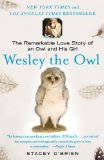Summary | Excerpt | Reading Guide | Reviews | Beyond the Book | Readalikes | Genres & Themes | Author Bio

The Remarkable Love Story of an Owl and His Girl
by Stacey O'Brien
Eventually, I was offered another position in a department that studied owls. After monkeys, who were practically human, I was afraid that working with owls might be boring. Back then I ignorantly thought, as many people do, that they were "just birds." They seemed aloof, and I knew little about them beyond the fact that they flew around at night. How interesting could that be? The only owls I had ever been around were in my grandmother's massive owl figurine collection, and I figured real owls were probably not too different. But the owl job was full-time and I really needed the money. Plus it offered opportunity to participate in research. It was a plum position for a young biologist because I could learn so much from those around me.
I accepted the owl job, and within six months grew to love these emotional, sassy little creatures as much as did the distinguished scientists who had been working with them for years.
"Stacey," said Dr. Ronan Penfield, one of the scientists, "the zoos and other institutions are overwhelmed with owls that can't go back to the wild, and this owlet needs placement. Taking him home would be a perfect opportunity for you to do a long-term, deeper study of an owl on a level that's just not possible in a purely academic setting."
"You mean I should adopt him?"
"That's exactly what I mean. Since his eyes are still closed, he will imprint on you if you take him right away, and you could make observations, record his sounds and behaviors..."
I was both thrilled and terrified by this opportunity -- scared by the enormous responsibility I would assume for this young life. I stared at Dr. Penfield to see if he was serious.
"...you may discover some things up close that we have not observed from a distance. I think this would be a beneficial study for our overall understanding of barn owls. You could keep us informed of your findings all along."
In spite of my fears, I wanted to leap across the desk, grab him by the shoulders, and shout, "Yes, I'll do it!" Instead I took a deep breath and tried to sound professional.
"I'll need to make some arrangements, but I would love to take him."
I was about to live with and raise one of the most beautiful animals on earth. Barn owls are quite different from all other owls. They are in a completely separate family called Tytonidae, while all other owls of the world are in the family Strigidae, meaning "typical owls." I was fascinated by all owls, but to have the chance to get to know the only representative of the nontypical owls that exist on the North American continent was very exciting.
The first bird, Archaeopteryx, began to appear in the fossil record during the Upper Jurassic period, around 155-150 million years ago. It had some dinosaur-like characteristics but was still clearly a bird. From then on, birds diverged, and owls would appear much later. My owlet was a bit of living history.
It's estimated that barn owls first started to appear in the fossil record during the Paleocene age (57.8-65 million years ago). The modern barn owl, Tyto, appeared around the middle of the Miocene period (5.3-23.7 million years ago) and diversified into various species during the Pliocene (1.6-5.3 million years ago) and Pleistocene (0.01-1.6 million years ago) periods. Wesley's species, Tyto alba, started showing up in the fossil record during the Pleistocene. Although owls are sometimes included in discussions of raptors, the truth is they are thought to be more closely related to nightjars than to diurnal (daytime) birds of prey (Falconiformes). Nightjars, which include whippoorwills, actually look like some kind of missing link between a regular bird and an owl.
Before I worked with owls I had never even heard of nightjars, and I used to skip over the parts of books that discussed how many millions of years ago an animal appeared on the world stage. But once I had my owl, this information became fascinating to me. His "tribe" had been here, probably living very close to where we were at that moment, for some 1.6 million years. What really blew my mind was that, in all that time, every single one of his ancestors had successfully bred and had a baby survive to breed. For 1.6 million years. There wasn't a single break in the chain, or he wouldn't have been here. Of course, this is true for every one of us who is on the planet -- which seems like an incredible miracle.
Copyright © 2008 by Stacey O'Brien
Your guide toexceptional books
BookBrowse seeks out and recommends the best in contemporary fiction and nonfiction—books that not only engage and entertain but also deepen our understanding of ourselves and the world around us.